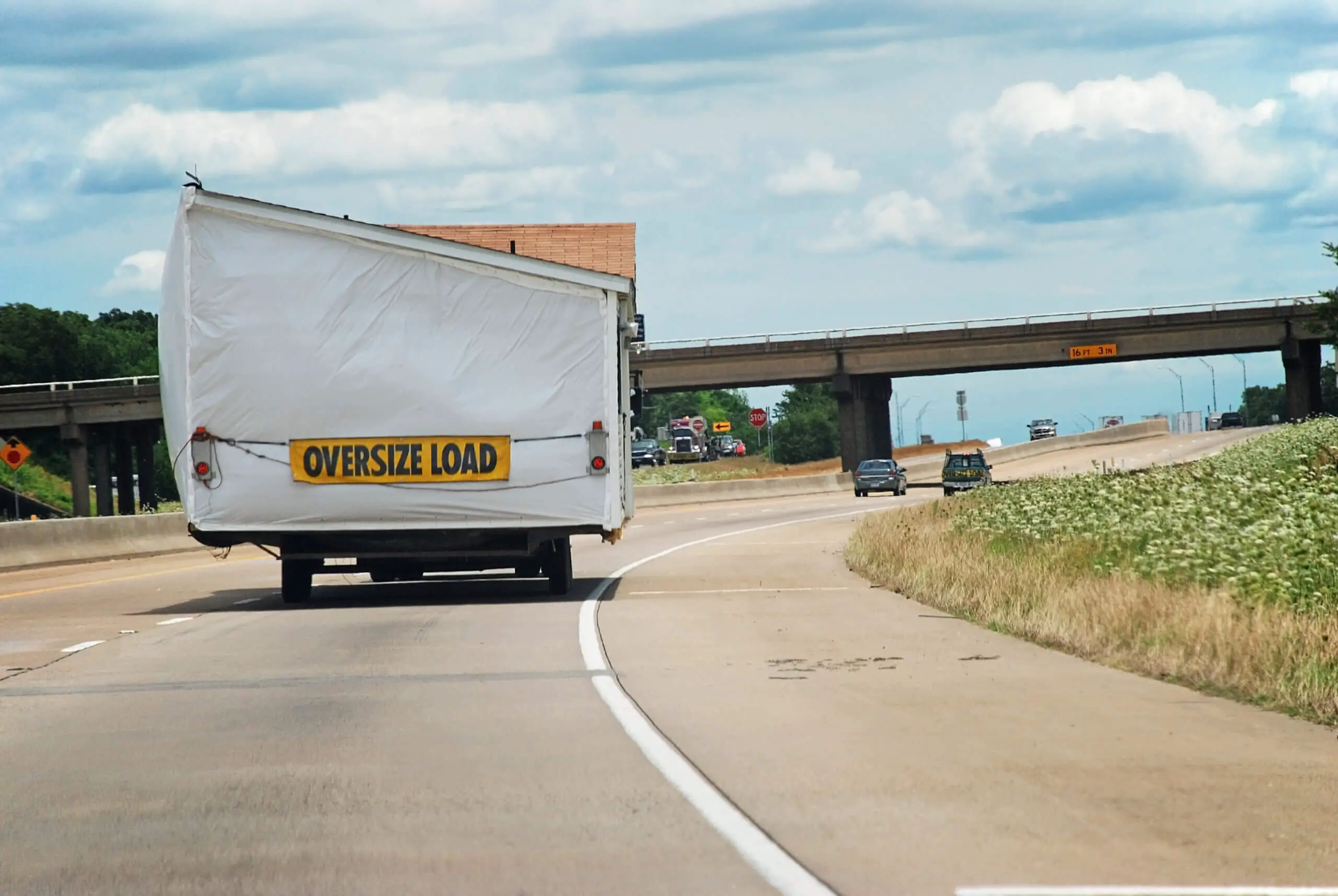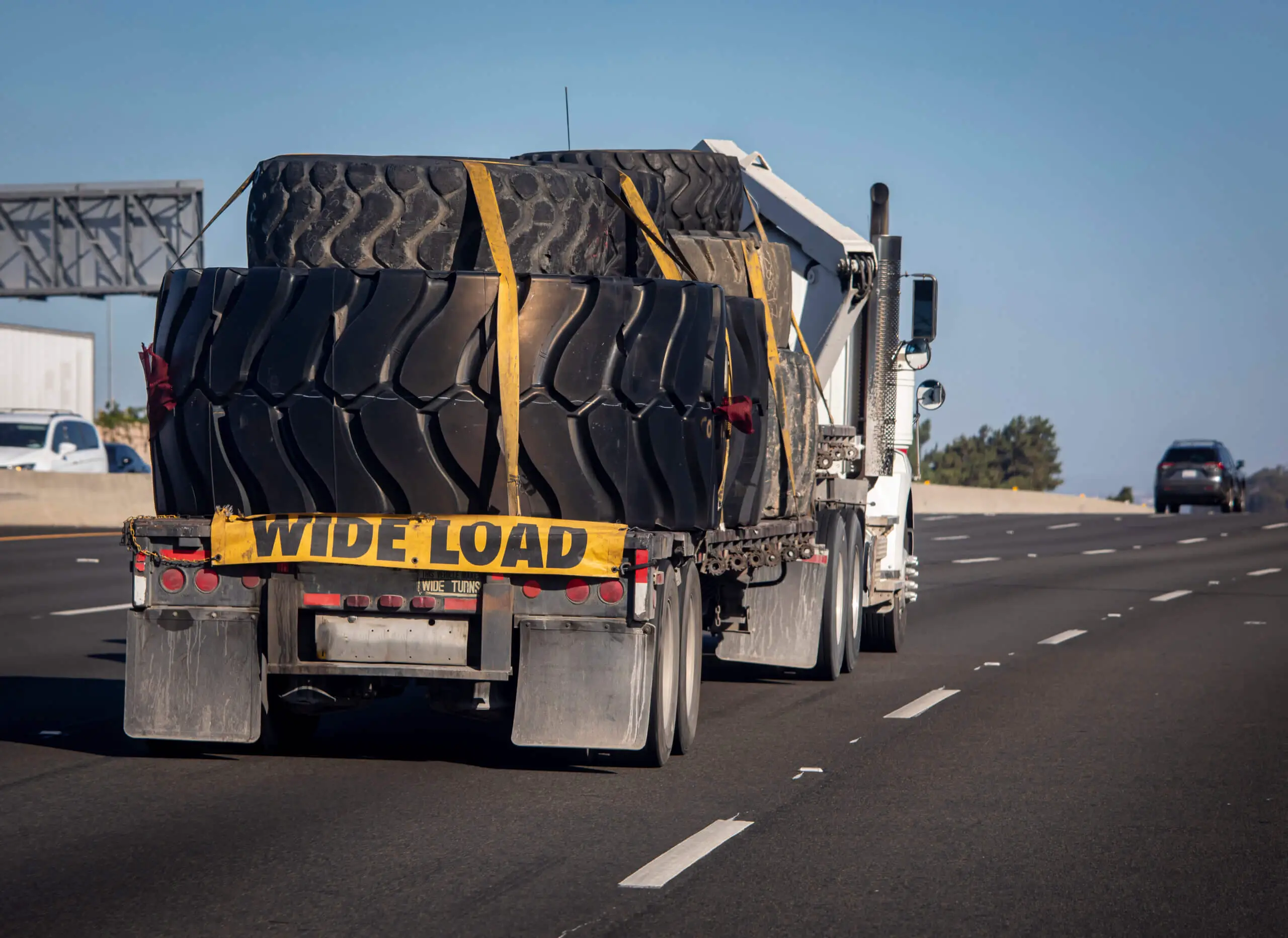If your load is wider than your flatbed trailer, you’re most likely hauling a wide load or an oversize load. And you’re going to need to get permits and adhere to some specific regulations before you can haul them. This is what we discuss in this post.
What Is A Wide Load?
A wide load or an oversized load is one that exceeds the maximum length, height, and/or width limit put in place by the state you’re traveling through.
The exact definition of a wide load varies from state to state. But in most states, your load is considered a wide load or oversized if it is wider than 8.5 feet. Also, if your load weight is more than 46,000 pounds, longer than 48 feet, or is taller than 13.5 feet, your lead is oversized in most states in the United States.
If your load is above any of the size limits put in place by state regulations, you would need permits to drive them within the state. Depending on the state, you may even need escort vehicles around the truck. And often, the wider the load, the longer it takes to get the permit to drive it within the state.
Requirements For Hauling Wide And Oversized Loads

Wide and Oversize loads require special permitting through certain highways and states.
Hauling oversize or wide loads often come with some requirements to put in mind. The reason these requirements exist is that oversize loads are potentially more dangerous. They are heavier or bigger than what other road users to, and any accident involving these huge loads tend to be less pleasant.
Some common requirements for hauling wide or oversize loads in the United States include the following:
Permits
Permits are important for the shipping of oversize or wide loads. Make sure you contact the state you intend to haul your load through and find out about their permit requirements.
Failure to secure permits before hauling through the state attracts penalties that cost anything from thousands of dollars in fines. And when you secure permits, you must be careful to comply with the rules and regulations of the state as it pertains to your wide or oversize loads. Failure to do this could cost you your permit.
We discuss some more about permits in a bit, but the United States Department of Transportation Federal Highway Administration has a list of contacts to reach for each state concerning oversize and overweight load permits for each state.
Escort Vehicles
Escort vehicles are normal passenger vehicles that go ahead and behind the truck carrying the wide/oversize loads. The idea of these escort vehicles is to alert other road users about the load and to ensure that there’s enough space between the truck and other vehicles.
Some states require escort vehicles for all oversize loads while others restrict escort vehicles to loads wider than 10 feet. It is also common that some states require two escort vehicles – one in the rear and the other in front.
When traveling from a state that doesn’t require escort vehicles to a state where escort vehicles are required, it is important that you have the escort vehicles waiting for you at the border of the new state.
And in some states, extra-wide loads require law enforcement escorts, such as state police or sheriff officers.
Running Times
Even when you get permits, the states determine when your oversize or wide loads can move. Communities and cities may also have a say in when you get to drive within their jurisdictions.
Some states restrict wide loads below 10 feet in width to night runs while those over 10 feet can only move during daytime. There are also situations when wide loads must only move at night so that they don’t interfere with high traffic times.
If you’re not sure, make sure to check the requirements of each state that lies on your route for running times for wide loads.
Safety Equipment
Oversize and wide loads always require special safety equipment to ensure that other vehicles on the road can easily recognize wide loads. These safety equipment include flags, warning signs, and lights.
Banners or signs that read “OVERSIZE LOAD” or “WIDE LOAD” must always be visibly positioned across the front of the truck and on the rear of the load. In addition to that, loads must have 18-inch orange or red flags protruding from the corners of the load. For times and areas of low visibility, lights are required in place of the flags.
Apart from the truck and the wide load, the escort vehicles must also bear these signals and safety equipment.
Cost
Depending on the state and the size of your load, permits cost anything from $15 to $70. However, some states allow you to create accounts with them so that you can have discounted fees if you use their roads frequently.
Insurance Requirement
In addition to the permits, another requirement states often place on carriers of oversize loads is an appropriate insurance level.
States have minimum insurance levels that the carrier must meet before they apply for permits to haul wide loads. The essence of this is to ensure that your insurance can cover whatever liability that occurs while hauling your oversized loads.
Wide And Oversized Loads Regulations

Heavy equipment tires being hauled on a flatbed trailer with a wide load sign
In addition to requirements, there are some regulations that you must pay attention to. As always, states determine what their regulations are, so you should look them up. But the general regulations include the following:
About Permits
The federal government is unconcerned about wide load permits. Rather, the states are in charge of issuing permits and setting the regulations within their borders. And if your shipment is going to take you through multiple states, you must attain the permits for hauling your oversized load within each state before you set out on that trip.
The state permit is not the only thing you need to secure. Depending on the state, you may also need local permits. When you apply for a permit to haul a wide load through a state, for instance, the agency tells you of other local agencies on your route whose permits you also need to secure. The responsibility then falls on you to secure those permits as well. All the states in the United States go through this procedure except for Georgia.
Depending on your load, you may secure a permit for a one-time haul, multiple hauls, or annual permits.
Routes
Typical interstate lanes are only 12 feet wide, with the size getting narrower the farther down roads of lower classifications. As a result, states often limit you to some routes. You may even have to submit your intended route to the state before you’re able to secure the permit.
Requirements, Regulations, and Permits By State
Since a huge part of hauling oversize and wide loads depend on the state you’re driving through, you can never go wrong with researching what the state you’re traveling through wants. That’s why we have this list of requirements, regulations, and permits by state.
Oversize/Overweight Load Permits - FHWA Freight Management and Operations (dot.gov)
New Mexico (NM) | Indiana (IN) | South Dakota (SD) | Nebraska (NE) | |
New York (NY) | Iowa (IA) | Tennessee (TN) | Nevada (NV) | |
North Carolina (NC) | Kansas (KS) | Texas (TX) | New Hampshire(NH) | |
North Dakota (ND) | Kentucky (KY) | Utah (UT) | New Jersey (NJ) | |
Ohio (OH) | Louisiana (LA) | Massachusetts (MA) | Vermont (VT) | |
Oklahoma (OK) | Maine (ME) | Michigan (MI) | Virginia (VA) | |
Oregon (OR) | Maryland (MD) | Minnesota (MN) | Washington (WA) | |
Hawaii (HI) | Pennsylvania (PA) | Mississippi (MS) | West Virginia (WV) | |
Idaho (ID) | Rhode Island (RI) | Missouri (MO) | Wisconsin (WI) | |
Illinois (IL) | South Carolina (SC) | Montana (MO) | Wyoming(WY) |
Summary
Oversize or wide loads are those that are beyond the maximum size or weight limit stipulated by every state. And because of the potential danger and the compromise other road users may make when these loads are being shipped, you always need state-given permits to haul them.
Without getting these permits and adhering to the regulations that surround hailing wide/oversize loads, you may incur huge penalties. So the next time you have an oversize load to ship, make sure you confirm the regulations of the state as it pertains to wide load shipping before you proceed. And it goes without saying that you should drive carefully.
